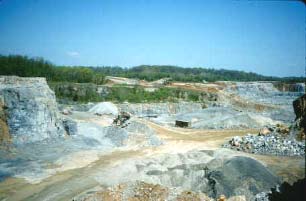
 and southeastern parts of the State. In these areas, the major limestone and
dolomite units are exposed at the surface and are accessed by about 30
quarries and four underground mines. Most production is from the Greenbrier
Group, Helderberg Group, St. Paul Group, and the Tomstown Dolomite.
In the central and western parts of the State, major limestone and dolomite
units are either absent or lie hundreds of feet beneath the surface. In
these areas, a small amount of production is from thin, Pennsylvanian-age
units; however, most of the material consumed in these areas is trucked in
from eastern West Virginia or barged in from out-of-state sources.
The outlook for future West Virginia production is excellent. Reserves are
enormous and production should only be limited by demand and other economic
factors. In addition, new markets and the development of previously untapped
resources may significantly increase statewide production levels.
Future production in central and western West Virginia may come from shaft
mining the Greenbrier Limestone where anticlines bring it close to the surface
near major markets or navigable waterways. Shaft mine in this region could
supply much of the material that is currently being imported from other states.
Recent clean-air legislation could create and sustain a significant increase
in the demand for limestone and dolomite. More coal-fired power plants are
choosing to install scrubbers on existing plants or utilize fluidized bed
boilers in new facilities, both of which used limestone and/or dolomite as
a sulfur-capturing sorbent material. It has been estimated that if all of the
coal-fired plants in West Virginia converted to these technologies, the
State's demand for limestone and dolomite could increase by up to 50%.
(adapted from a compilation by Hobart M. King and Claudette M. Simard, updated September 1996)
and southeastern parts of the State. In these areas, the major limestone and
dolomite units are exposed at the surface and are accessed by about 30
quarries and four underground mines. Most production is from the Greenbrier
Group, Helderberg Group, St. Paul Group, and the Tomstown Dolomite.
In the central and western parts of the State, major limestone and dolomite
units are either absent or lie hundreds of feet beneath the surface. In
these areas, a small amount of production is from thin, Pennsylvanian-age
units; however, most of the material consumed in these areas is trucked in
from eastern West Virginia or barged in from out-of-state sources.
The outlook for future West Virginia production is excellent. Reserves are
enormous and production should only be limited by demand and other economic
factors. In addition, new markets and the development of previously untapped
resources may significantly increase statewide production levels.
Future production in central and western West Virginia may come from shaft
mining the Greenbrier Limestone where anticlines bring it close to the surface
near major markets or navigable waterways. Shaft mine in this region could
supply much of the material that is currently being imported from other states.
Recent clean-air legislation could create and sustain a significant increase
in the demand for limestone and dolomite. More coal-fired power plants are
choosing to install scrubbers on existing plants or utilize fluidized bed
boilers in new facilities, both of which used limestone and/or dolomite as
a sulfur-capturing sorbent material. It has been estimated that if all of the
coal-fired plants in West Virginia converted to these technologies, the
State's demand for limestone and dolomite could increase by up to 50%.
(adapted from a compilation by Hobart M. King and Claudette M. Simard, updated September 1996)
Please send questions, comments, and/or suggestions to webmaster.
Page created and maintained by:
West Virginia Geological and Economic Survey
Address: Mont Chateau Research Center
1 Mont Chateau Road
Morgantown, WV 26508-8079
Telephone: 304-594-2331
FAX: 304-594-2575
Hours: 8:00 a.m. - 5:00 p.m. EST, Monday - Friday
Permission to reproduce this material is granted if acknowledgment is given to the West Virginia Geological and Economic Survey.